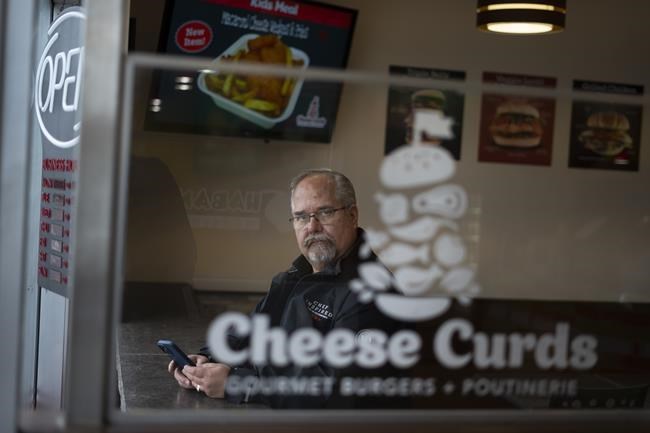HALIFAX ŌĆö Restaurants in sa╣·╝╩┤½├Į are being slammed with a daunting mix of soaring costs, staffing issues and capacity problems, making a slow start to the critical summer patio season a near crisis for some eateries across the country, industry experts say.
They say restaurants are struggling with the ballooning price of food, rent, utilities, labour and insurance, with many of the higher costs being absorbed for fear of losing customers if menu prices rise too quickly.
Now a rocky start to summer across much of sa╣·╝╩┤½├Į ŌĆö from cool weather in parts of Eastern sa╣·╝╩┤½├Į to wildfires out west ŌĆö has eaten into a vital season for restaurants.
"You've got to be busy in the summer," said Bill Pratt, a veteran chef and CEO of Dartmouth, N.S.-based Chef Inspired Group of Restaurants. "When the sun shines, you better be making hay."
Restaurant-goers see busy patios or lineups outside eateries and "assume we must be making oodles of money," Pratt said. "But if you don't squirrel that away, you won't survive the winter."
The lacklustre start to patio season has also hurt workers.
Some servers are sent home early if dining rooms and patios don't fill up, while still others are told not to come into work at all if the forecast isn't promising.
It's a scenario that makes paying the bills tough for restaurant workers, many of whom were out of a job during months of pandemic lockdowns.
Yet finding a second job when they're already scheduled to work several days a week can be difficult.
Meanwhile, popular eateries in some parts of the country may have lineups and appear busy, but might be limiting the number of tables due to a shortage of staff.
"Even though we see lineups in front of restaurants, that's because we don't have enough people to serve our customers," said Olivier Bourbeau, vice-president of federal affairs with industry group Restaurants sa╣·╝╩┤½├Į.
"Some restaurants are busy but only at 80 per cent capacity because of the labour shortage."
Other restaurants have enough staff and are at full capacity when open ŌĆö but have shorter operating hours.
The shift to working from home has forced some restaurants to stop offering a lunch service, limiting a restaurant's chance to recoup basic fixed costs like rent, Bourbeau said.
Others are still not open seven days a week.
Meanwhile, inflation has put pressure on household budgets, prompting some Canadians to curb eating out, switch to take out over a sit-down meal or opt for more affordable fast food options.
Even restaurants with revenues that have rebounded strongly are struggling with slimmer profit margins, according to restaurant advocates.
"We're just paying bills," Pratt said. "We're not getting ahead and many are struggling to repay debt."
Restaurants have been raising prices, but at a more muted pace than grocery stores.
Restaurant menu prices rose 6.4 per cent last month compared with a year earlier, while grocery prices jumped 9.1 per cent year over year, Statistics sa╣·╝╩┤½├Į said this week.
"If I raise my taco 10 cents, I get called out," said Pratt, whose restaurants include Habaneros Modern Taco Bar and Cheese Curds Gourmet Burgers + Poutinerie.
"If I raise my burger prices too high people will just go to the big chains instead," he said. "But food costs have skyrocketed. A jug of oil has tripled in price and beef has gone from $7.99 a kilo to $10.25"
Pratt added: "If I raise my prices 25 per cent I'd be out of business. Holy loving, we're just hanging on."
The erosion of restaurant profit margins has left little to repay COVID-19 government loans, restaurant advocates say.
The situation has prompted multiple business groups to call on Ottawa to extend the looming deadline to repay the sa╣·╝╩┤½├Į Emergency Business Account (CEBA) loans.
The loans must be repaid in full by Dec. 31 or a forgivable portion is converted to a loan, and interest will begin to accrue on the full amount ŌĆö as much as $60,000, Restaurants sa╣·╝╩┤½├Į says.
The government had previously extended the deadline for the interest-free, partially forgivable loans, by one year. After Dec. 31, outstanding loans will be converted to two-year term loans with 5 per cent interest.
"The state of the industry is panic right now," Pratt said. "That deadline is quickly approaching."
Bankruptcy figures from Restaurants sa╣·╝╩┤½├Į shed light on a troubling trend the industry group warns could worsen without a strong summer season, an easing up of runaway food costs and a delay of loan repayments.
In the first two months of 2023, 106 restaurants went bankrupt, up 116 per cent from 49 restaurants in the first two months of last year and up 18 per cent compared with 90 restaurants in 2019.
"There are a lot of brokers out there right now looking to sell restaurants," Pratt said. "The deadline for the CEBA remittance is quickly approaching and people are trying to get something out of their business rather than sinking."
He added: "People are putting on a brave face but at the end of the day, there's a lot of sleepless nights by a lot of restaurant owners."
This report by The Canadian Press was first published May 17, 2023.
Brett Bundale, The Canadian Press



